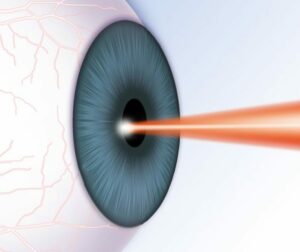If you’re considering LASIK, there are a few things you need to know. In this blog post, we’ll cover the different types of LASIK procedures and how to choose the right one for you. We’ll also go over the risks and benefits of LASIK surgery, so you can make an informed decision about whether or not it’s right for you. So read on to learn everything you need about getting LASIK options!
Contents
What Is LASIK Surgery?

LASIK surgery is a laser eye procedure used to correct vision problems related to nearsightedness (myopia), farsightedness (hyperopia), and astigmatism. The LASIK procedure reshapes the cornea, the clear outer surface of your eye, to improve how light is focused onto your retina. This enables you to see more clearly without relying on eyeglasses or contact lenses.
This surgery is a relatively fast, outpatient procedure that is performed by an ophthalmologist or optometrist. Before the surgery, you will be given numbing eye drops to reduce any discomfort caused by the laser as it reshapes your cornea. During the procedure, a thin flap is created in your eye and lifted so that the laser can access your cornea. A computer-guided laser then reshapes your cornea according to your prescription before the flap is placed back over it and allowed to heal naturally.
After LASIK surgery, you may experience improved vision within 24 hours of the procedure, but full results may take several days or weeks. In some cases, there are side effects associated with this surgery such as dry eyes, light sensitivity, and night glares. However, most of these side effects will dissipate over time.
Different LASIK Options

There are several different types of laser-assisted in situ keratomileuses (LASIK) eye surgery procedures that can be used to correct vision issues. These include traditional LASIK, wavefront LASIK, and custom LASIK, as well as other more advanced options.
The detailed description of these are:
LASEK
One of the more popular types of laser vision correction surgery is LASEK, which stands for laser-assisted subepithelial keratomileusis. With this procedure, a thin layer of tissue is removed from the outer surface of the cornea and reshaped with an excimer laser. The reshaped cornea is then replaced and bandaged with a contact lens to protect it while it heals. This type of surgery is recommended for patients with thin corneas or high levels of astigmatism.
People who are considering LASEK should be aware that it takes a longer recovery period than with traditional LASIK surgery, which can involve some additional discomfort.
PRK/Epi-LASIK
PRK, or photorefractive keratectomy, and Epi-LASIK are two similar types of laser vision correction procedures. Instead of removing a layer of tissue to reshape the cornea, these procedures use an excimer laser to ablate (remove) the outermost surface layer of cells on the cornea, while leaving the inner layers intact. This type of surgery can be used if a patient’s cornea is too thin for traditional LASIK and is often preferred by athletes due to its reduced risk of complications.
Epi-LASIK is a less invasive variant of PRK, which uses an epikeratome to create a thin flap in the outermost layer of cells on the cornea instead of ablating them. This type of surgery is growing in popularity due to its shorter recovery time and reduced risks compared to traditional LASIK.
Wavefront LASIK
Wavefront LASIK is a more advanced form of laser vision correction. It uses wavefront technology, which measures how light waves are distorted as they pass through the eye. This data is then used to create a personalized ablation pattern that is tailored to each patient’s individual visual needs. Wavefront LASIK typically provides better visual outcomes than traditional LASIK and has a lower risk of side effects such as glare or halos around lights at night.
In Sight LASIK
In-Sight LASIK is a newer form of laser vision correction that uses a 3D mapping system to create more precise and personalized ablation patterns. It has been shown to provide excellent visual outcomes with reduced risk of side effects, making it an attractive option for those seeking the best possible results from their laser vision correction surgery.
In-SIGHT LASIK is a great option for those looking for improved vision without the risks associated with traditional LASIK or PRK. It also has a shorter recovery time than traditional LASIK, making it an ideal choice for busy people who need their vision corrected quickly.
Custom LASIK
Custom LASIK takes wavefront-guided LASIK one step further by using specialized software to create an even more precise map of the eye’s curvature. This allows for a customized surgery plan that can treat higher-order aberrations and provide improved visual outcomes. This LASIK option also has a low risk of side effects, making it a popular choice for those who want to reduce or eliminate their dependence on glasses and contacts.
Overall, there are many options available when it comes to laser vision correction. Different types of LASIK may be recommended depending on the condition of your eyes and your individual visual needs. It’s essential to speak with an eye doctor about which option is right for you to ensure that you get the best possible outcome from your surgery.
How To Select From Different LASIK Options?

Selecting a LASIK operation can be a daunting task if you are new to the procedure. There are many different options available and it is important to research each one thoroughly before making a final decision.
Many factors may influence your decision when choosing a LASIK procedure.
- The first step is to consult with an ophthalmologist or optometrist to determine if you are a good candidate for the type of surgery you are considering. Your doctor will be able to discuss the pros and cons of each option and help you make an informed decision.
- The next step is to understand the different types of LASIK options available. Each option has its risks, benefits, costs, and recovery time so it’s important to research them carefully before making any final decisions. Some common LASIK procedures include PRK (photorefractive keratectomy), Wavefront-guided laser vision correction, and custom LASIK surgery. These procedures can correct a range of vision problems including hyperopia, myopia, and astigmatism. It is important to discuss the options with your doctor so they can advise you on which one is best for your needs.
- Finally, it’s important to consider the cost of each LASIK option. Some procedures may be more expensive than others but this does not necessarily mean that one option is superior to another. Be sure to research all available costs and ask questions about any additional fees or services associated with the procedure.
When selecting from different LASIK options, it’s critical to do your research and weigh the risks and benefits carefully. Talk to your doctor about all of your options so you can make an educated decision about the best course of action for your vision. Ultimately, you should feel comfortable and confident with your choice.
Conclusion
LASIK is a safe and effective way to reduce or eliminate your need for glasses or contact lenses. It is quick, painless, and offers many benefits including improved vision with little to no discomfort afterward. Depending on your situation and lifestyle needs, there are different Lasik options available to you.
Your eye doctor can help you decide which option would be best for you based on several factors such as your visual acuity, corneal thickness, age, and lifestyle needs. With proper care after the procedure, most people will experience clear vision without the need for glasses or contacts. So if you’re considering refractive surgery to improve your vision, LASIK may be right for you! Talk to your doctor today about all the Lasik options available.
Lasik surgery is a safe 10-minute procedure to help you get rid of glasses. MantraCare offers the most advanced LASIK options. If you have any questions on LASIK surgery feel free to reach out to us at +91-9711116605.
